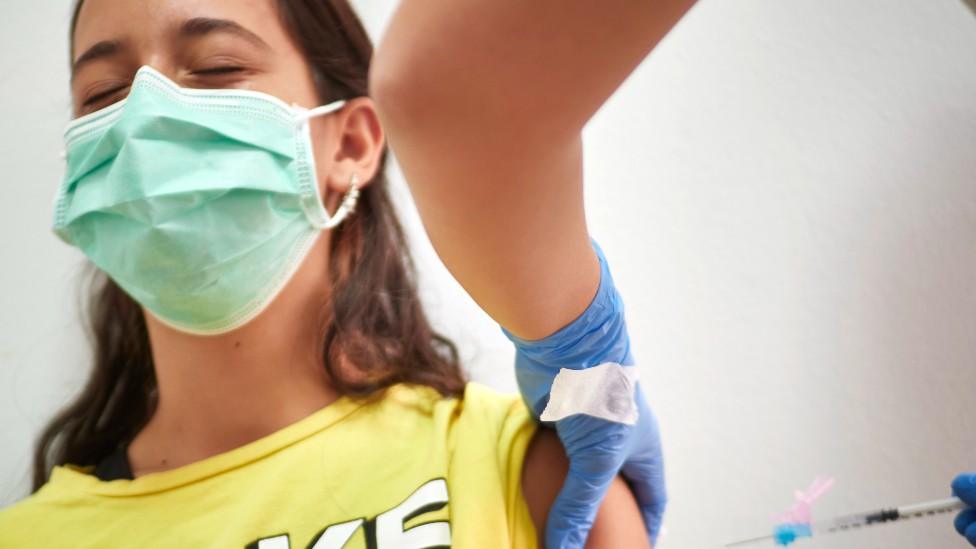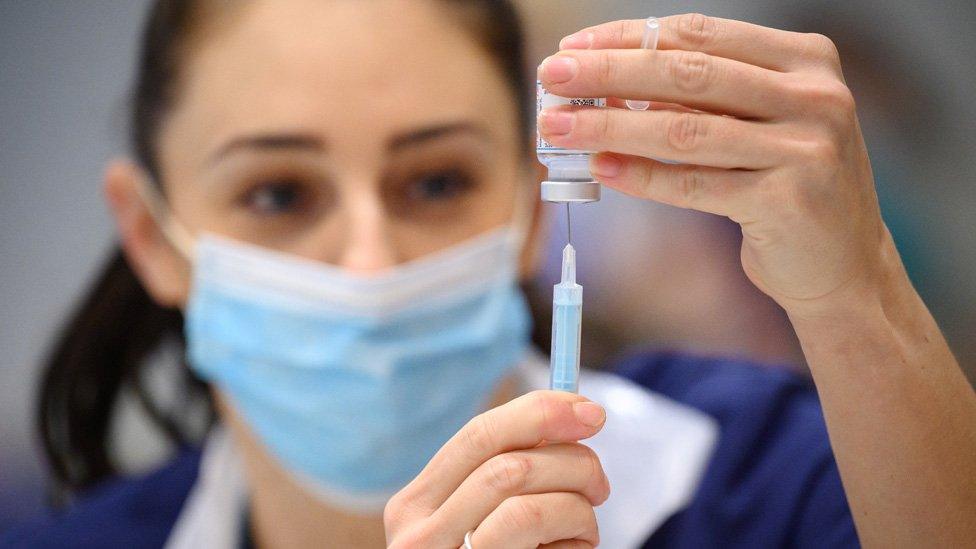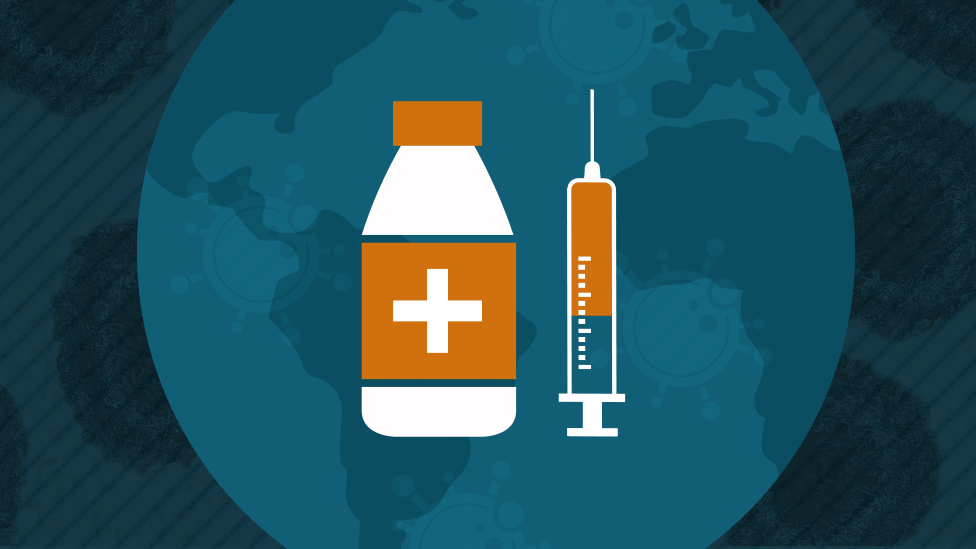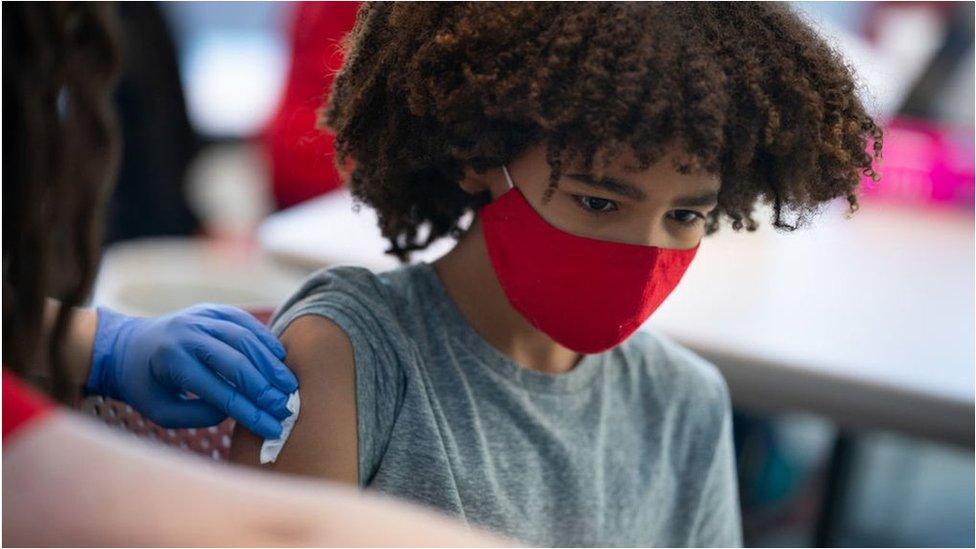What difference will jabbing young teens make?
- Published

A teenager in Spain receives the Covid vaccine
All children aged 12 to 15 in the UK are to be offered one dose of the Pfizer-BioNTech Covid jab.
It follows a recommendation from the UK's four chief medical officers that vaccinating them would help reduce disruption to their schooling this winter and benefit those growing up in the poorest areas.
The UK's advisory body, the JCVI, said there was only a marginal benefit to vaccinating adolescents on health grounds alone and stopped short of recommending it - but it did advise vaccinating children over 12 with specific underlying health conditions who are at greater risk.
What we do know?
There is general agreement that this was a really tricky call to make.
Strong opinions have been expressed on all sides, by scientists, doctors, teachers and parents alike.
The JCVI focused squarely on the health benefits of vaccination to children themselves - not on the impact to their schooling or other people.
Children's risk from Covid isn't zero but the chances of them becoming seriously ill from Covid are incredibly small. Deaths among healthy children are extremely rare - most have life-limiting health conditions.
That means there needs to be a clear and obvious advantage to giving them a jab.
However, a very rare side-effect of the Pfizer and Moderna vaccines has made that calculation a lot more complicated.
Paul Hunter, professor of medicine at University of East Anglia, says there's been intense pressure on the JCVI and he can understand why they have been cautious.
So what are the unknowns?
Research on millions of people who've had the mRNA vaccines (Pfizer and Moderna) shows there's a tiny risk of myocarditis, or inflammation of the heart, which is more common in young people - and particularly younger boys - after a second dose. It can cause chest pain and a pounding heart, but symptoms usually clear up in days.
No vaccine or drug is ever 100% safe, and data from the US shows the numbers of children affected are very small.
For every million Pfizer second doses given to 12-17-year-old-boys, around 60 had the condition, external (compared with eight in a million among girls). The rates in this age group are higher than in older ones - and it's why only one dose for 16 and 17-year-olds in the UK has been recommended, for now.
But being infected with Covid has consequences for teenagers' health too - including their hearts - so how big is that risk?
A recent US study suggests having Covid-19 could be six times more likely to trigger myocarditis, external in young men than the vaccine, with a rate of about 450 per million infections.
However, the long-term effects of myocarditis after vaccination and the wider health impacts of Covid in children in the short and long-term are still not known.

Why do countries differ on their approach?
Just because countries have access to the same data doesn't mean they will reach the same standpoint on this finely-balanced question.
Countries are influenced by a variety of different factors - from vaccination rates in adults to political pressure and fears over another wave of Covid.
The US, for example, has vaccinated more than 10 million over-12s and concluded that the benefits of protecting against Covid illness and its complications "far outweigh" the small potential risk of an adverse reaction to the vaccine, external.
France, Italy, Canada, Spain, Israel and many other countries are all vaccinating this age group for the same reason.
What would jabbing children achieve?
Vaccinating secondary-school-age children wouldn't stop the virus circulating in schools or in society more generally.
"Even if 100% of people in the UK were vaccinated - and their pets - the virus would still spread," Prof Hunter says.
But vaccines for teens are still likely to reduce infections in that age group, and could help keep more children in school over winter, although it's unclear how much it would limit wider community spread.
The government's scientific advisers recently said that 40-70% of children in secondary schools may already have been infected by the start of term, meaning many have some in-built protection.
Then there's the question of whether encouraging more over-18s to have a vaccine would be a more productive aim, given their greater risk, with more than 12% still reluctant to even have one?
In the end it comes down to choice, and a fine balance between a very rare side-effect from the vaccine, and a very low risk to children themselves from Covid.
Related topics
- Published2 September 2021

- Published1 September 2021

- Published2 April

- Published2 September 2021

- Published9 July 2021

- Published1 June 2022

- Published4 June 2021
